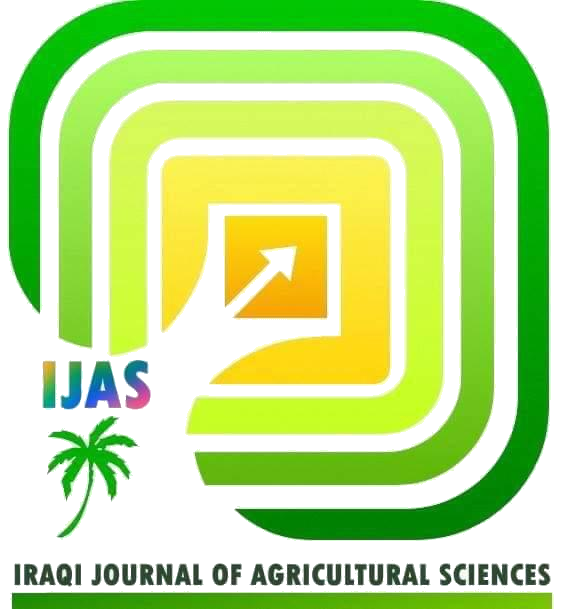GROWTH AND YIELD QUALITY OF SWEET CORN, AS INFLUENCED BY NITROGEN FERTILIZATION LEVELS IN SULAIMANI REGION
DOI:
https://doi.org/10.36103/vdr8bp68Keywords:
sweet corn, environmental and climatic conditions, sweetness, varieties responses.Abstract
Four sweet corn varieties (Zea mays ssp. Saccharata), Gold Rush (v1) and Chocolate (v2), originated from Japan and 001(v3), and 003 (V4) are France originated, were cultivated under the effect of three different levels of nitrogen fertilization (120, 170and 230 ) kg ha-1as (N1, N2, and N3) in two different locations in Sulaimani region (Bakrajo and Kanipanka), Iraqi Kurdistan Region in order to investigate the effects of some environmental and climatic factors on growth performance and yield quality of sweet corn varieties in the open field. By using a factorial experiment within RCBD with three replications, the results revealed that indicated to significant differences in the response of four varieties under the effect of the Nitrogen fertilization levels in both locations in the criteria concerned with sweetness such as TS%,TSS%, and NSS%, while the significant effect of Nitrogen levels N2 and N3 were revealed in quality related criteria TS% and TSS% in both locations.
References
1.A.O.A.C.1990.Official Method of Analysis of Association of Agriculture Chemists, 15th ed., AOAC, Washington, D. C., U. S. A. pp:363
2.ASAE Standards, 43rded.1996. S352.2.Moisture Measurement Ungrounded Grain and Seeds. St. Joseph, Mich.: ASAE. pp:497
3.Daughtry, C. S. T. and S. E., Hollinger. 1984. Costs of Measuring Leaf Area Index of Corn. Purdue University. Purdue University LARS Technical Reports. pp: 27.
http://docs.lib.purdue.edu/larstech/27
4.Drost, D.2010.Sweet Corn in the Garden. Utah State University, Cooperative Extension. (HG/Garden/ 2005-10pr).
https://extension.usu.edu/files/publication.
5.Elsahookie, M.M. 1990. Maize Production and Breeding. Ministry of Higher Education and Scientific Research. University of Baghdad, pp. 400.
6.Fekonja,M., F.Bavec, S.Grobelnik-Mlakar, M.Turinek, M.Jakop and M.Bave.2011.Growth performance of sweet maize under non-typical maize growing conditions. Biological Agriculture and Horticulture, 27:147–164.
7.Fritz,V.A., C.B. Tong, C.J.Rosen and J.A.Wright.2010.Sweet corn (vegetable crop management),University of Minnesota, extension.
http://www.extension.umn.edu/garden
8.Hart, J.M., D.M. Sullivan, J.R. Myers, and R.E. Peachey.2010. Nutrient Management Guide, Sweet Corn. Oregon State Univ. Extension service, pp: 21.
9.Hochmuth, G. and E.D. Hanlon.2013. A Summary of N, P, and K Research with Sweet Corn in Florida. Fla. Coop. Ext. Serv. Cir. SL. pp: 326.
10.Kar,P.P., K.C. Barik, P.K. Mahapatra, L.M. Garnayak, B.S. Rath, D.K. Bastia and C.M. Khanda.2006.Effect of planting geometry and nitrogen on yield, economics and nitrogen uptake of sweet corn (Zea mays). Indian Journal of Agronomy,51(1):43-45.
11.Lazcano, C., Revilla, P., Malvar, R. A. and Domínguez, J. 2011, Yield and fruit quality of four sweet corn hybrids (Zea mays) under conventional and integrated fertilization with vermicompost. J. Sci. Food Agric., 91: 1244–1253
12.National Bureau of Agricultural Commodity and Food Standards Ministry of Agriculture and Cooperatives.2012. Thai Agricultural Standard, TAS 1512-2011. Published in the Royal Gazette Vol.129 Section 14D Special, Dated 10 January B.E. 2555.pp:17.
13.Ramankutty,N., J.A. Foley, J. Norman and K. McSweeney. 2002. The global distribution of cultivable lands: Current patterns and sensitivity to possible climate change. Global Ecol. Biogeography. 11:377–392.
14.Madhava Rao,K.V.,A.S. Raghavendra, K. Janardhan Reddy.2006. Physiology and Molecular Biology of Stress Tolerance in Plants. Printed in the Netherlands, Springer. pp: 1-14.
15.Shaheenuzzamn.M, R. R. Saha, B. Ahmed, J. Rahman, and A. Salim.2015.Green cob and fodder yield of sweet corn as influenced by sowing time in the hilly region. Bangladesh J. Agril. Res., 40 (1): 61-69.
16.Szymanek, M., B. Dobrzañski jr, I.Niedziólka and R. Rybczyñski.2005. Sweetcorn, Harvest and Technology, Physical Properties and Quality. Centre of Excellence Agrophysics for Applied Physics in Sustainable Agriculture;B. Dobrzański institute of Agro physics of Polish Academy of Sciences, Poland,pp:234.
17.Tolenaars, J.2013. Corn maturity and heat units. University of Guelph. Cited from http://www.plant.uoguelph.ca.
18.Ugur, A. and H. A. Maden.2015. Sowing and planting period on yield and ear quality of sweet corn (Zea mays l. Var. Saccharata). Ciênc. Agrotec, 39 (1): 1413-7054.
19.Wang.Q.Y. Jiang and L. Guilan.2006. Effect of nitrogen and potassium on grain yield and quality of sweet maize.Jor. ofMaize Sciences, 03.
20.Warman, P.R. and K. H. Harvard. 1996. Yield, vitamin and mineral content of four vegetables grown with either composted manure or conventional fertilizer. Journal of Vegetable Crop Production 2(1): 13-25.
21.Warman, P.R. and K.H.Harvard.1998. Yield, vitamin and mineral contents of organically and conventionally grown potatoes and sweet corn. Agriculture, Ecosystems and Environment,68(3): 207–216.
22.William, M.2014.Better sweet corn research, better production. ACES.College of Agricultural, Consumer and Environmental SciencesACES News and Public Affairs.University of Illinois, Urbana, Illinois, USA. http://www.uiuc.edu
Downloads
Published
Issue
Section
License
Copyright (c) 2025 IRAQI JOURNAL OF AGRICULTURAL SCIENCES

This work is licensed under a Creative Commons Attribution-NonCommercial 4.0 International License.

2.jpg)
 https://orcid.org/0000-0002-5774-5906
https://orcid.org/0000-0002-5774-5906 



